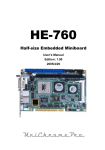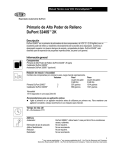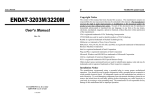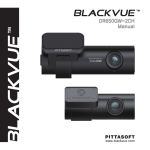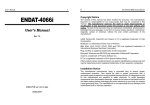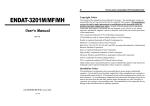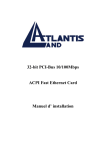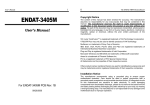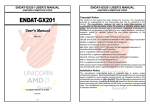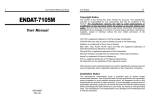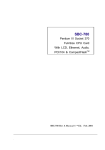Download - UNICORN
Transcript
I User’s Manual ENDAT-3205M/S User’s Manual Rev. 2C II The ENDAT-3205M/S System Board Copyright Notice The content of this manual has been checked for accuracy. The manufacturer assumes no responsibility for any inaccuracies that may be contained in this manual. The manufacturer reserves the right to make improvements or modification to this document and/or the product at any time without prior notice. No part of this document may be reproduced, transmitted, photocopied or translated into any language, in any form or by any means, electronic, mechanical, magnetic, optical or chemical, without the prior written permission of the manufacturer. VIA is registered trademark of VIA Technology Incorporation VT82C686B may only be used to identify products of VIA Technology Realtek is registered trademark of Realtek Technologies Inc. Multiscan is a trademark of Sony Corp of America IBM, EGA, VGA, PC/XT, PC/AT, OS/2 and PS/2 are registered trademarks of International Business Machines Corporation Intel is a registered trademark of Intel Corporation Plug and Play is registered trademarks of Intel Corporation Microsoft, Windows and MS-DOS are trademarks of Microsoft Corporation AMI is a trademark of American Megatrends Inc. PCI is a registered trademark of PCI Special Interest Group Other product names mentioned herein are used for identification purpose only and may be trademarks and/or registered trademarks of their respective companies. Installation Notice For 3205M PCB ver. 1D or later 3205S PCB ver: 1B or later 11/02/2005 The manufacturer recommends using a grounded plug to ensure proper motherboard operation. Care should be used in proper conjunction with a grounded power receptacle to avoid possible electrical shock. All integrated circuits on this motherboard are sensitive to static electricity. To avoid damaging components from electrostatic discharge, please do not remove the board from the anti-static packing before discharging any static electricity to your body, by wearing a wrist-grounding strap. The manufacturer is not responsible for any damage to the motherboard due to improper operation. III User’s Manual IV Specification: This manual covers three different layout models, and the respective board layouts are shown in chapter 1-4 and 1-5. Please refer to the following description to make sure which model on hand before using. Model Form Factor CPU Supporting LAN Adapter IDE Connector FDD Connector AC97’ Audio ENDAT-3205M ENDAT-3205S Mini-ITX 170 mm x 170 mm (6.69”x6.69”) Embedded VIA Low Power Consumption C3 series (FAN required) / Eden Series (FAN-less) Socket370 Intel Tualatin/ Pentium3/Celeron/VIA C3 Realtek 8139D or Intel 82551QM 10/100 Based LAN Realtek 8139D only for both of LAN chip, LAN2 is optional 2 x 40pin IDE connectors support UDMA 33/66/100, 1 x 44pin connector support Slim type HDD (share to IDE1) 1 x FDD connector 2 x 40pin IDE connectors support UDMA 33/66/100, 1x CF socket by optional N/A Phone Jack + Pin Header Phone Jack + Pin Header Wafer only Wafer only Cash Drawer System Chipset DIMM Socket VGA Adapter VIA ProSavage4 AGP4x 2D/3D Graphic Controller w/ SMA 8/16/32MB Display ratio 4:3 and 16:9 LCD Supporting 8, 16, 24bit CSTN/ DSTN LCD panel with TTL interface 9, 12, 18, 24, 36 TFT LCD Panel with TTL interface 18, 24, 36bit LVDS interface (24bit LVDS is optional) I/O Port Digital IO WDT RS-422/485 4 x COMs w/+5V, +12V selector /1 x Parallel port VIA VT8606 + VIA VT82C686B One DIMM Socket supports 512MB 6 bit Digital Input (optional)/ 2 bit Output 1 to 255 seconds S/W programmable by optional feature Optional via COM2 Expansion Slot 1x120Pin PCI connector + Intel Embedded ATX edge connector for three PCI slot expansion via riser card USB Port Power Supply 4 x USB1.1 onboard ATX power support The ENDAT-3205M/S System Board TABLE OF CONTENTS CHAPTER 1. INTRODUCTION ....................................................... 1 1-1. 1-2. 1-3. 1-4. 1-5. FEATURES .............................................................................................. 3 UNPACKING ............................................................................................ 5 ELECTROSTATIC DISCHARGE PRECAUTIONS ................................... 5 MOTHERBOARD LAYOUT (ENDAT-3205M)........................................... 6 MOTHERBOARD LAYOUT (ENDAT-3205S) .......................................... 7 CHAPTER 2. SETTING UP THE MOTHERBOARD ....................... 8 2-1. JUMPERS AND CONNECTORS (ENDAT-3205M)................................... 8 2-2. JUMPERS AND CONNECTORS (ENDAT-3205S) ................................. 15 2-3. INSTALLING MEMORY.......................................................................... 22 2-4. SHARED VGA MEMORY ....................................................................... 22 2-5. INSTALLING RISER CARD.................................................................... 22 2-6. ASSIGNING IRQs FOR EXPANSION CARDS ....................................... 22 2-7. WATCH DOG TIMER………………………………………………………….24 2-8 DIGITAL I/O AND CASH DRAWER…………………………………………..25 CHAPTER 3. AWARD BIOS SETUP............................................. 28 3-1. STANDARD COMS FEATURES............................................................. 28 3-2. ADVANCED BIOS FEATURES............................................................... 29 3-3. ADVANCED CHIPSET FEATURES ........................................................ 31 3-4. INTEGRATED PERIPHERALS............................................................... 34 3-5. POWER MANAGEMENT SETUP........................................................... 36 3-6. PnP/PCI CONFIGURATIONS................................................................. 39 3-7. PC HEALTH STATUS ............................................................................. 40 User’s Manual V CHPATER 4. VGA, LCD, FEATURE.............................................. 41 4-1. AGP-BUS VGA FEATURE...................................................................... 41 4-2. LCD FLAT PANEL FEATURE ................................................................. 42 4-3. PCI BUS AUDIO ADAPTER FEATURES................................................ 43 4-4. DRIVER UTILITY INSTALLATION GUIDE ............................................. 44 CHPATER 5. LAN ADAPTER ........................................................ 46 5-1. FEATURES ............................................................................................ 46 5-2. UTP CABLE/RJ-45 JACK DEFINITION .................................................. 47 5-3. CONNECTING 100BASE-TX FAST ETHERNET NETWORK ................ 48 5-4. CONNECTING 10BASE-T ETHERNET NETWORK .............................. 48 5-5. 10MBASE/ 100MBASE INSTALLATION NOTICE .................................. 48 5-6. REMOTE BOOT ROM FUNCTION ........................................................ 49 5-7. LED INDICATORS.................................................................................. 49 5-8. THE SETUP PROGRAM ....................................................................... 50 APPENDIX A: FLASH MEMORY UTILITY.................................... 52 APPENDIX B: CONNECTOR PIN ASSIGNMENT ........................ 53 APPENDIX C: LIMITED WARRANTY ........................................... 65 User’s Manual 1 Chapter 1. Introduction In order to cope with the challenges of the system heating issues and demand of much more diminutive embedded system in diverse application, ENDAT-3205M system board provides the ultimate solution by integrating with VIA’s technology low power consumption VIA C3 series (FAN required) CPUs and VIA Eden (FAN-less) series CPUs. ENDAT-3205M not only provide the ideal solution for Hi-End POS system, but also can be adapted in various applications such as kiosks, networking systems, controlling terminals and other embedded systems. To provide higher performance solution, The ENDAT-3205S system board provides the ultimate design support the INTEL Tualatin / PIII / Celeron CPUs. ENDAT-3205M is highly integrated industrial grade system board to support 133/100/66 MHz CPU FSB (“Front Side Bus”) frequency and based on 64-bit to support VIA C3 / Eden series embedded processors. ENDAT-3205M / ENDAT-3205S are designed with VT8606 “Twister-T” North Bridge and the VT82c686B Super South Bridge. Support One DIMM Socket of DRAM up to 512MBbyte of system memory with 256Mbit DRAM technology. The DRAM controller supports standard PC133 and PC100 Synchronous DRAM (SDRAM). The DRAM bank can be composed of an arbitrary mixture of 1M / 2M / 4M / 8M / 16M / 32MxN DRAMs. The DRAM controller can run at either the host CPU FSB at 133/100 MHz. ENDAT-3205M/S are integrate S3 Graphics’ 128-bit ProSavage4 graphics accelerator which support mainstream graphics perform with leading-edge 2D, 3D and DVD video acceleration. Based on its integrated AGP 4X solution, and support the Microsoft DirectX Texture Compression (DXTC) to deliver unprecedented 3D performance and image quality. With utilizes a single cycle architecture that provides high performance along with superior image quality. Several new features to enhance 3D architecture, including single-pass multi-texturing, anisotropy filtering, and an 8-bit stencil buffer to enable stunning image quality without losing on performance. ENDAT-3205M/S strongly supports a wide variety of DSTN or TFT panels through a 36-bit TTL/CMOS interface from 4:3 and 16:9 mode displays. Which include VGA, SVGA, XGA, and SXGA+ TFT color panels with 9-bit, 12-bit, 18-bit (both 1 2 The ENDAT-3205M/S System Board pixel/clock and 2 pixels/clock), and 24-bit TTL/CMOS interfaces. Its enhanced STN hardware with 256 gray scale support and advanced frame rate control can provide up to 16.7 million colors. In addition, the integrated 2-channel LVDS interface can support 18-bit (36-bit) color panels. All resolutions are supported up to SXGA+ (1400x1050). ENDAT-3205M/S provides standard PCI slot with Intel embedded ATX defined can support more than 2 PCI expansions via the edge connector along with the standard onboard PCI slot. This board is not only fully compatible with industry standards, but also thousand of software application; such as WIN 95, 98, WIN ME, WIN XP, WIN NT 3.x / 4.x, WIN 2000, WIN CE (.NET), Linux, UNIX, Novell…etc. The control logic provides high-speed performance for the most advance multi-user, multitasking application. Tomorrow’s PC technology is here today. The ideal solution of ENDAT-3205M/ ENDAT-3205S - POS system - KIOSK - Interactive system - Airport Terminal Controller - Industrial controller - Digital entertainment - Embedded system equipment User’s Manual 3 4 The ENDAT-3205M/S System Board Ordering information: 1-1. Features Basic Feature: z z z z z z z z z z z z ENDAT-3205M: supports VIA EBGA type of C3 / Eden series processors with 133/100/66 MHz Front Side Bus (FSB) ENDAT-3205S: supports Socket370 Intel Tualatin / Pentium III / Celeron / FCPGA / FCPGA2 series processors with 133/100/66 MHz Front Side Bus (FSB) DRAM interface runs synchronous (133/133 or 100/100) mode. Supports standard PC133 and PC100 SDRAM up to 512MB Full internal AGP 4x performance with 8/16/32 MB frame buffer share with system memory Integrated ProSavage4 2D/3D/Video Accelerator, with next generation, 128-bit 2D graphics engine resolutions up to 1920x1440 Direct Flat panel interface support 36-bit DSTN/TFT flat panel interface support 4:3 and 16:9 display, with 256 gray shade support up to SXGA+(1920x1400x16) Integrated 2-channel 110 MHz LVDS interface Simultaneous display of CRT with LCD Panel 6 bit digital input / 2 bit output Built-in Cash drawer controller. AC97’ Audio support with 1.5W amplifier built-in Full Software Support z Drivers for major operating systems and APIs: Windows 9x / ME, Windows NT 4.0, Windows 2000, Windows XP, Direct3D, DirectDraw and DirectShow, OpenGL ICD for Windows 9x, NT, and 2000, and DXVA for Windows 2000 and Windows XP ENDAT-3205M 1. ENDAT-3205M-1R-10: Supports 1 Realtek LAN, C3 1GHz, LVDS 18 and 36 bits 2. ENDAT-3205M-1RL-10: Supports 1 Realtek LAN, C3 1GHz, and LVDS 24 bits 3. ENDAT-3205M-1R-E8: Supports 1 Realtek LAN, Eden ESP8000, LVDS 18 and 36 bits 4. ENDAT-3205M-1RL-E8: Supports 1 Realtek LAN, Eden ESP8000, and LVDS 24 bits ENDAT-3205S 1. ENDAT-3205S-1R: Support 1 Realtek LAN, LVDS 18 and 36 bits 2. ENDAT-3205S-1RL: Support 1 Realtek LAN and LVDS 24 bits 3. ENDAT-3205S-2R: Support 2 Realtek LAN, LVDS 18 and 36 bits 4. ENDAT-3205S-2RL: Support 2 Realtek LAN and LVDS 24 bits Note: 1. The standard version of ENDAT-3205M is embedded with VIA C3 1 GHz and one Realtek LAN chip. Other option will be provided upon request. 2. All VIA C3 series and Socket 370 type CPUs are Heat sink and FAN required. User’s Manual 5 1-2. Unpacking The motherboard comes securely packaged in a sturdy cardboard shipping carton. In addition to the User's Manual, the motherboard package includes the following items: • • • • ENDAT-3205M/S System Board HDD/FDD/Serial port Cables LCD cable (Optional) IDE Driver includes: Drivers for Windows NT 3.x/4.x, Windows 95, 98, ME, 2000, XP, Novell Netware and AMI / AWARD FLASH ROM utilities. • Driver utilities for on-board VGA drivers, LAN adapter If any of these items are missing or damage, please contact the dealer from whom you purchase the motherboard. Save the shipping material and carton in the event that you want to ship or store the board in the future. Note: Leave the motherboard in its original package until you are ready to install it! 1-3. Electrostatic Discharge Precautions Make sure you properly ground yourself before handling the motherboard, or other system components. Electrostatic discharge can easily damage the components. Note: You must take special precaution when handling the motherboard in dry or air-conditioned environments. 6 1-4. ENDAT-3205M The ENDAT-3205M/S System Board User’s Manual 1-5. ENDAT-3205S 7 8 The ENDAT-3205M/S System Board Chapter 2. Setting up the Motherboard 2-1. Jumpers and Connectors (ENDAT-3205M) Jumpers/Connectors Overview: Function Jumpers/Connectors Cooling Fan Connector JFAN1, JFAN2 LAN Adapter Disable/Enable JP1 COM Ports Power Selector (COM1, 2, 3, 4) JP5, JP10 RS232/RS422/RS485 Selector (COM2) JP8, JP9 LCD: TFT LCD Panel Connector LCD_C1, LCD_C2 LVDS LCD Output Port LVDS1 24 bit LVDS trigger edge JP3: Pin 1, 3, 5 LVDS backlight power/control CN3 TFT LCD Voltage Selector JP2, JP3: Pin 2, 4, 6 LCD clock timing adjustment JP4 Internal VGA port CN5 COM4 Box header CN7 MIC IN, LINE IN, CD IN CN10, CN11, CN12 Speaker out / internal speaker out CN9, CN13 Digital I/O header JP7 Cash drawer connector CN4 Clear CMOS JBAT1 Factory default SW1, JP6: Pin 9~11 PS/2 Mouse/KB Pin Header CN1, JKBMS2 OEM MS/KB Header JKBM2 IR CN8 USB Port (0-3) JRJ1A, JUSB1 LAN port JRJ1B FDD Connector FDD1 IDE 1, IDE2 IDE1, IDE2 Slim IDE IDEB1 9 User’s Manual Function Header for Case Panel IDE LED External Speaker Buzzer On/Off Hardware Reset Switch Power Good Select: External PG Internal PG ATX Power Supply On/Off Switch Power LED Jumpers/Connectors JP6 JP6: Pin 1 (–), Pin 2 (+) JP6: Pin 3, Pin 6 JP6: Pin 4, Pin 5 JP6: Pin 7, Pin 8 JP6: Pin 9-10 JP6: Pin 10-11 JP6: Pin 12, Pin 13 JP6: Pin 14 (–), Pin 15 (+) Please double-check the insertion and orientation of the LCD cable before applying power. Improper installation will result in permanent damage LCD panel. Part 1: Onboard Jumpers JP1: On-board LAN Disable/Enable (2.0mm) Enable * Close Pin 1-2 Disable Close Pin 2-3 JBAT1: CMOS Data Clear (2.0mm) Pin 1-2 Close for clear CMOS, the default setting is OPEN. JP8, JP9: RS232 / 422 / 485 Selector for COM2 (2.0mm) TYPE JP8 (3x4/2mm) JP9 (2x7/2mm) RS-232 * 1-2, 4-5, 7-8, 10-11 1-2 RS-422/485 (2 wire) 2-3, 5-6, 8-9, 11-12 5-6, 9-11, 10-12 RS-422/485 (4 wire) 2-3, 5-6, 8-9, 11-12 3-4, 7-8 * Make sure the port mode has been set up correctly before installing any peripherals. JP5 (COM1, 2) / JP10 (COM3, 4) Voltage Selector (2.0mm) Voltage COM1 (JP5) COM2 (JP5) COM3 (JP10) COM4 (JP10) 1-2 7-8 1-2 7-8 +12V(DC) 3-4 9-10 3-4 9-10 R.I. * 5-6 11-12 5-6 11-12 +5V(DC) 10 The ENDAT-3205M/S System Board JP6: Case Panel Connection (2.54mm) Pin No. Description HDD_LED (1:LED–, 2:LED+) 1-2 PC speaker 3-6 Onboard Buzzer 4-5 * Hardware RESET 7-8 9-10: External PG, 10-11: Internal PG 9-10-11 Power On/Off 12-13 Power LED (14:LED-, 15:LED+) 14-15 JP3 (Pin 2, 4, 6), JP2: Voltage Selector for LCD panel LCD power JP2 (2.54mm) JP3 (2.0mm) VDDLCD is 5V Open Close 2-4 VDDLCD is 3.3V * Open Close 4-6 VDDLCD is 12V Close Pin 2, 4, 6 must Open Caution: Improper setting will damage LCD panel. JP3 (Pin 1, 3, 5): 24 bit on-board LVDS trigger edge selector (2.0mm) Pin No. Function Rising edge 1,3 * Falling edge 3,5 JP4: LCD Panel clock timing adjustment (2.0mm). Pin No. Function 1,2 * No delay 3,4 Delay 5n Sec 5,6 Delay 10n Sec 7,8 Delay 15n Sec 9,10 Delay 20n Sec 11,12 Delay 25n Sec 11 User’s Manual Part 2: Onboard connectors JFAN1, JFAN2: CPU / 2nd Cooling Fan Connector Pin No. Function Sensor Pin. 1 +12V 2 GND 3 Box Header Type Connector for COM port (RS-232) Pin No. Function Pin No. Function DCD DSR 1 6 RXD RTS 2 7 TXD CTS 3 8 DTR RI 4 9 GND N.C 5 10 D-SUB Type Connector for COM2 port (RS-422Æ 4 Wire) Pin No. 1 2 3 4 5 Function –TXD +RXD +TXD NA NA Pin No. 6 7 8 9 Function NA NA NA –RXD D-SUB Type Connector for COM2 port (RS-485Æ 2 Wire) Pin No. 1 2 3 4 5 Function Data – NA Data + NA NA Pin No. 6 7 8 9 J1: IR Connector (2.54mm) VCC Pin 1 Pin 4 N.C Pin 2 Pin 5 IRRX Pin 3 Function NA NA NA NA GND IRTX 12 The ENDAT-3205M/S System Board CN7: PS/2 Keyboard / Mouse Pin Header Connector (2.54mm) Pin No. Signal (KB) Pin No. Signal (MS) 1 KB Data 2 MS Data 3 KEY 4 KEY 5 GND 6 GND 7 +5V(DC) 8 +5V(DC) 9 KB_CLK 10 MS_CLK JKBMS2: Pin Header for external device (2.0mm) Pin No. Signal (KB) Pin No. Signal (MS) KB Data Out MS Data Out 1 2 KB Data In MS Data In 3 4 KB CK Out MS Data Out 5 6 KB CK In MS CK In 7 8 KEY KEY 9 10 +5V(DC) +5V(DC) 11 12 GND GND 13 14 Default setting is: 1-3, 5-7, 2-4 and 6-8 close. JUSB1: USB port 2, 3 (2.54mm) Pin No. Function Pin No. USB2_VCC 1 2 USBD2– 3 4 USBD2+ 5 6 USB_GND2 7 8 USB_GND2 9 10 Function USB3_VCC USBD3– USBD3+ USB_GND3 USB_GND3 CN12: CD IN (2.54mm) Pin No. Function LEFT 1 GND 3 Pin No. 2 4 Function GND RIGHT CN11: LINE IN (2.54mm) Pin No. Function RIGHT 1 GND 3 Pin No. 2 4 Function GND LEFT 13 User’s Manual CN10: Microphone IN (2.54mm) Pin No. Function Pin No. 1 MIC POWER 2 3 GND 4 Function GND MIC IN CN13: Internal speaker out (2.54mm) Pin No. Function Pin No. RIGHT 1 2 GND 3 4 Function GND LEFT JP7: Digital I/O connector (2.54mm) Pin No. Function Pin No. OUT0 1 2 OUT1 3 4 INPUT4 5 6 INPUT5 7 8 +12V 9 10 KEY 11 12 GND 13 14 Function INPUT0 INPUT1 INPUT2 INPUT3 +12V +5V GND 14 The ENDAT-3205M/S System Board CN5: Internal VGA Connector (2.54mm) CN4: Cash drawer connector (JST connector) Pin No. Function DRAWER1 1 SENSOR 2 +12V 3 DRAWER2 4 GND 5 CN3: LCD - LVDS backlight power and ON/OFF control (JST connector) Pin No. Function VBL (+12V) 1 VBL (+12V) 2 ON (+5V)/OFF (GND) 3 GND 4 GND 5 Pin No. 1 2 3 4 5 6 7 8 Description RED GREEN BLUE N.C GND GND GND GND Pin No. 9 10 11 12 13 14 15 Description N.C / +5V GND N.C DDC DAT H-Sync V-Sync DDC CLK Note: Please refer to the appendix B for data mapping of LCD connector User’s Manual 2-2. Jumpers and Connectors (ENDAT-3205S) Jumpers/Connectors Overview: Function Jumpers/Connectors Cooling Fan Connector JFAN1, JFAN2 LAN Adapter Disable/Enable JP12 COM Ports Power Selector (COM1, 2, 3, 4) JP4, JP10 RS232/RS422/RS485 Selector (COM2) JP5, JP9 LCD: TFT LCD Panel Connector LCD_C1, LCD_C2 LVDS LCD Output Port LVDS1 24 bit LVDS trigger edge JP1: Pin 1, 3, 5 LVDS backlight power/control CN1 TFT LCD Voltage Selector JP1: Pin 2,4, 6, JP2 LCD clock timing adjustment JP3 Internal VGA port CN4 COM4 Box header CN7 MIC IN, LINE IN, CD IN CN11, CN10, CN9 Speaker out / internal speaker out CN8, CN14 nd 2 LAN header CN12 Digital I/O header JP7 Cash drawer connector CN5 Clear CMOS JBAT1 Factory default JP6, JP8 PS/2 Mouse/ KB Pin Header CN2, JKBMS1 IR CN13 USB Port (0-3) JRJ1A, JUSB1 LAN port JRJ1B IDE 1, IDE2 IDE1, IDE2 CF Master/Slave select JP11 JP13 Header for Case Panel JP13: Pin 1 (–), Pin 2 (+) IDE LED External Speaker JP13: Pin 3, Pin 6 Buzzer On/Off JP13: Pin 4, Pin 5 15 16 The ENDAT-3205M/S System Board Function Hardware Reset Switch Power Good Select: External PG Internal PG ATX Power Supply On/Off Switch Power LED Watch Dog Timer enable Switch Jumpers/Connectors JP13: Pin 7, Pin 8 JP13: Pin 9-10 JP13: Pin 10-11 JP13: Pin 12, Pin 13 JP13: Pin 14 (–), Pin 15 (+) JP13: Pin 16, Pin 17 Please double-check the insertion and orientation of the LCD cable before applying power. Improper installation will result in permanent damage LCD panel. Part 1: Onboard Jumpers JP12: LAN Enable / Disable: Pin No. Function 1-2 * LAN1 Enable 2-3 LAN1 Disable 4-5 * LAN2 Enable 5-6 LAN2 Disable JBAT1: CMOS Data Clear: Pin 1-2 Close for clear CMOS, the default setting is OPEN. JP5, JP9: RS232 / 422 / 485 Selector for COM2: TYPE JP9 (3x4/2mm) JP5 (2x7/2mm) 1-2, 4-5, 7-8, 10-11 1-2 RS-232 * 5-6, 9-11, 10-12 RS-422/485 (2 wire) 2-3, 5-6, 8-9, 11-12 3-4, 7-8 RS-422/485 (4 wire) 2-3, 5-6, 8-9, 11-12 * Make sure the port mode has been set up correctly before installing any peripherals. JP4 (COM1, 2) / JP10 (COM3, 4) Voltage Selector: Voltage COM1 (JP4) COM2 (JP4) COM3 (JP10) COM4 (JP10) 1-2 7-8 1-2 7-8 +12V(DC) 3-4 9-10 3-4 9-10 R.I. * 5-6 11-12 5-6 11-12 +5V(DC) User’s Manual JP13: Case Panel Connection: Pin No. Description HDD_LED (1:LED–, 2:LED+) 1-2 3-6 PC speaker 4-5 * Onboard Buzzer 7-8 Hardware RESET 9-10-11 9-10: External PG, 10-11: Internal PG Power On/Off 12-13 Power LED (14:LED-, 15:LED+) 14-15 Watch Dog Timer Enable 16-17 JP1: LCD power selector / Onboard 24bit LVDS trigger edge: LCD Power (+Volts) JP1 JP2 Pin No (JP2) Function Rising edge 3.3 * 4-6 Open 1-3 * Falling edge 5 1-3 Open 3-5 12 Open Close Caution: Improper setting will damage LCD panel. 17 18 The ENDAT-3205M/S System Board Part 2: Onboard connectors JFAN1, JFAN2: CPU / 2nd Cooling Fan Connector: Pin No. Function Sensor Pin. 1 +12V 2 GND 3 Box Header Type Connector for COM port (RS-232) Pin No. Function Pin No. Function DCD DSR 1 6 RXD RTS 2 7 TXD CTS 3 8 DTR RI 4 9 GND N.C 5 10 D-SUB Type Connector for COM2 port (RS-422Æ 4 Wire) JP3: LCD Panel clock timing adjustment (2.0mm): Pin No. Function 1-2 * No delay 3-4 Delay 5n Sec 5-6 Delay 10n Sec 7-8 Delay 15n Sec 9-10 Delay 20n Sec 11-12 Delay 25n Sec JP11: CF Master/Slave select: Pin No Function Slave 1-2 * Master 2-3 Pin No. 1 2 3 4 5 Function –TXD +RXD +TXD NA NA Pin No. 6 7 8 9 Function NA NA NA –RXD D-SUB Type Connector for COM2 port (RS-485Æ 2 Wire) Pin No. 1 2 3 4 5 Function Data – NA Data + NA NA Pin No. 6 7 8 9 CN13: IR Connector (2.54mm) VCC Pin 1 Pin 4 N.C Pin 2 Pin 5 IRRX Pin 3 Function NA NA NA NA GND IRTX 19 User’s Manual CN2: PS/2 Keyboard / Mouse Pin Header Connector (2.54mm) Pin No. Signal (KB) Pin No. Signal (MS) 1 KB Data 2 MS Data 3 KEY 4 KEY 5 GND 6 GND 7 +5V(DC) 8 +5V(DC) 9 KB_CLK 10 MS_CLK JKBMS2: Pin Header for external device (2.0mm) Pin No. Signal (KB) Pin No. Signal (MS) KB Data Out MS Data Out 1 2 KB Data In MS Data In 3 4 KB CK Out MS Data Out 5 6 KB CK In MS CK In 7 8 KEY KEY 9 10 +5V(DC) +5V(DC) 11 12 GND GND 13 14 Default setting is: 1-3, 5-7, 2-4 and 6-8 close. JUSB1: USB port 2, 3 (2.54mm) Pin No. Function Pin No. USB2_VCC 1 2 USBD2– 3 4 USBD2+ 5 6 USB_GND2 7 8 USB_GND2 9 10 Function USB3_VCC USBD3– USBD3+ USB_GND3 USB_GND3 CN9: CD IN (2.54mm) Pin No. Function LEFT 1 GND 3 Pin No. 2 4 Function GND RIGHT CN10: LINE IN (2.54mm) Pin No. Function RIGHT 1 GND 3 Pin No. 2 4 Function GND LEFT 20 The ENDAT-3205M/S System Board CN11: Microphone IN (2.54mm) Pin No. Function Pin No. 1 MIC POWER 2 3 GND 4 Function GND MIC IN CN14: Internal speaker out (2.54mm) Pin No. Function Pin No. RIGHT 1 2 GND 3 4 Function GND LEFT JP7: Digital I/O connector (2.0mm) Pin No. Function Pin No. OUT0 1 2 OUT1 3 4 INPUT4 5 6 INPUT5 7 8 +12V 9 10 KEY 11 12 GND 13 14 Function INPUT0 INPUT1 INPUT2 INPUT3 +12V +5V GND CN5: Cash drawer connector (2.54mm) Pin No. Function DRAWER1 1 SENSOR 2 +12V 3 DRAWER2 4 GND 5 CN1: LCD - LVDS backlight power and ON/OFF control (JST connector) Pin No. Function VBL (+12V) 1 VBL (+12V) 2 ON (+5V)/OFF (GND) 3 GND 4 GND 5 21 User’s Manual CN4: Internal VGA Connector (2.0mm) Pin No. 1 2 3 4 5 6 7 8 Description RED GREEN BLUE N.C GND GND GND GND Pin No. 9 10 11 12 13 14 15 Description N.C / +5V GND N.C DDC DAT H-Sync V-Sync DDC CLK Note: Please refer to the appendix B for data mapping of LCD connector 22 The ENDAT-3205M/S System Board 2-3. Installing Memory The ENDAT-3205M/S CPU board offers one 168pin DIMM socket supporting up to 512MB of memory. The DIMM memory can be 100MHz (PC-100) or 133 MHz (PC-133). 2-4. Shared VGA Memory The ENDAT-3205M/S is using built-in AGP VGA controller with Share Memory Architecture (SMA) - AGP mode with up to 32MB of system memory. The amount of video memory on motherboard determines the number of colors and the video graphic resolution. 2-5. Installing Riser Card Installing Riser Card (Max. 2 PCI Slots on Riser Card) PCI Slot INT ADSEL PCI 1 A,B,C,D AD24 PCI 2 B,C,D,A AD23 PCI 3 C,D,A,B AD22 PCI 4 D,A,B,C AD21 (On Board LAN) The default INT/AD-select for ENDAT-3205M/S All-In-One motherboard is listed in the above table. 2-6. Assigning IRQs for Expansion Cards The IRQ number is automatically assigned to PCI expansion cards after those used by onboard device. To install a PCI riser card, you need to set the correct "ADSEL" and "INT" (interrupt) assignment. Please refer to "Chapter 2-5" Installing Riser Card for detail assignments. 23 User’s Manual IRQ 0 1 2 3 4 5 6 7 8 9 10 11 12 13 14 15 Status Used Used Used Used Used Used Used Used Used Used Used Used Used Used Used Used Assignment Timer Keyboard Second 8259 COM2 COM1 COM3 Floppy Disk LPT1 RTC LPT2 or Audio COM4 LAN Adapter (on board) PS/2 Mouse Coprocessor Hard Disk (IDE 1) Reserved (IDE 2) 24 The ENDAT-3205M/S System Board 2-7. Watch Dog Timer (optional function) Watch Dog Timer (WDT) is a special design for system to monitor and secure that system can work normally. WDT is used an independent ISA device for support this function. When time is up, WDT would send hardware RESET signal to reset system. Operators need to write a value into WDT port. The detailed operate instruction is shown below: WDT port address 305h (1 byte data) 306h (address trigger) 307h (address trigger) 308h (address trigger) FUNCTION DESCRIPTION Set the time up value (1-255), unit: SEC Enable WDT Disable WDT Refresh/ clear WDT counter WDT Setup Procedure: 1) Disable WDT: Please make sure WDT is not working before process. Send one byte (any value) into system address (307H) to disable WDT working status. The sample code is shown below (using TurboC/C++ 3.0): #define WDT_DISABLE 0x307 outportb(WDT_DISABLE,0x0); 2) Set a time-up value by 305H: Set the time-up value to WDT. The unit is second and range from 1 to 255 seconds. The sample code is shown below (using TurboC/C++ 3.0): #define WDT_TIME_VALUE 0x307 #define WDT_TIME_UP_VALUE 10 outportb(WDT_TIME,WDT_TIME_UP_VALUE); 3) Enable WDT: Enable WDT counter “on” and start increasing counter. Send one byte (any value) into system address (306H) to enable WDT. The sample code is show below (using TurboC/C++ 3.0): #define WDT_ENABLE 0x306 outportb(WDT_ENABLE,0x0); 25 User’s Manual 4) REFRESH/CLEAR WDT: The ENDAT-3205M/S System Board 3) Digital output control port: Repeatedly write WDT REFRESH port (308H) with any data and the interval cannot be longer than the preset time. Otherwise, WDT will send hardware RESET signal to reset system. The sample code is shown below (using TurboC/C++ 3.0): #define WDT_REFRESH 0x308 outportb(WDT_REFRESH,0x0); 2-8. Digital I/O & Cash Drawer control (Optional feature for input, function combined with WDT H/W) 1) Pin out of digital I/O header (JP7): Pin No. Function OUT0 1 OUT1 3 INPUT4 5 INPUT5 7 +12V 9 KEY 11 GND 13 26 This function is built in the system South-Bridge. ENDAT-3205x can offer 2 different logic level (3.3V and 12V) outputs at the same time. The digital output port can be written directly by porting address “404Eh” and the default value is “00h (data mapping to bit6 for OUT1 and bit7 for OUT0)”. The JP7 only provides 0V/3.3V and CN4 only provides 0V/12V output. The sample code is shown below (using TurboC/C++ 3.0): #define OUT_PORT 0x404e outportb(OUT_PORT,0x80); //Set OUT0 as logic “1” and OUT1 as “0” outportb(OUT_PORT,0x40); //Set OUT1 as logic “1” and OUT0 as “0” outportb(OUT_PORT,0xc0); //Set OUT0 and OUT1 as logic “1” 4) Cash drawer port: Pin No. 2 4 6 8 10 12 14 Function INPUT0 INPUT1 INPUT2 INPUT3 +12V +5V GND 2) Digital input control port: The digital input function and WDT function are both supported by H/W WDT chip. Either one cannot work without H/W WDT chip! The digital input port can be read directly from port address “30Ah” and the default value is “FFh (data mapping to bit0 to bit5)”. ENDAT-3205x is with onboard pull-up resistors (4.7K ohm to +5V) and decoupling capacitor (180pF to system GROUND) for each input pin to prevent any unexpected noise. The input level is 2.5V, 3.3V and 5V (+/-5% range). The sample code is shown below (using TurboC/C++ 3.0): #define INPUT_PORT 0x30a unsigned char read_data; read_data=inportb(INPUT_PORT); //Read status from INPUT port Attention: The WDT chip might be damaged by over specifying voltage. a). Pin out of cash drawer connector (internal JST connector): Pin No. Function 1 DRAWER1 2 SENSOR 3 +12V 4 DRAWER2 5 GND b). Digital output control port: This function offers 2 controls (0V/+12V) to open the cash drawer. It can be used for DIGITAL I/O control with 0V/+12V level also. The input level of SENSOR pin (pin2) must be 12V, and the SENSOR pin can be read from bit0 of DIGITAL INPUT port. The sample code is shown below (using TurboC/C++ 3.0): #define OUT_PORT 0x404e #define INPUT_PORT 0x30a unsigned char read_data; outportb(OUT_PORT,0xc0); //Set all cash drawer not open (+12V) outportb(OUT_PORT,0x40); //Set DRAWER1 open (0V) outportb(OUT_PORT,0x80); //Set DRAWER2 open (0V) outportb(OUT_PORT,0x00); //Set all cash drawer open (0V) read_data=inportb(INPUT_PORT); //Read status from INPUT port read_data=read_data&0x01; //Get the status of sensor 27 User’s Manual The diagram shown below is the detailed schematic of this interface: R138 1K 4 DIO-I0 BC143 .1u 1 NC7SZ04M5X Q7 FDD6030L_TO-252 SOT-23 R200 U33 4.7K 1 2 3 5 4 BC160 .1u 1 NC7SZ04M5X Q14 FDD6030L_TO-252 SOT-23 BC161 470pF 1 2 3 CASH-I2 4 IOGND1 5 SWL1 SW+ 12V L2 1x5/2.54mm WAFER IOGND1 CASH-I2 1K +12V R208 2.2K 3 DIO-O1 IOGND1 R199 2 +12V IOGND1 The ENDAT-3205M/S System Board Chapter 3. AWARD BIOS SETUP CN4 CASH-I R207 10K 5 3 R140 U32 4.7K 1 2 3 2 +12V DIO-O0 IOGND1 CASH-I 28 IOGND1 Phoenix – Award BIOS CMOS Setup Utility > Standard CMOS Features > Frequency/Voltage Control > Advanced BIOS Features Load Optimized Defaults > Advanced Chipset Features Set Supervisor Password > Integrated Peripherals Set User Password > Power Management Setup Save & Exit Setup > PnP/PCI Configurations Exit Without Saving > PC Health Status Use the CMOS setup program to modify the system parameters to reflect the environment installed in your system and to customize the system as desired. Press the <DEL> key to enter into the CMOS setup program when you turn on the power. Settings can be accessed via arrow keys. Press <Enter> to choose an option to configure the system properly. In the main menu, press F10 or “SAVE & EXIT SETUP” to save your changes and reboot the system. Choose “EXIT WITHOUT SAVING” to ignore the changes and exit the setup procedure. Pressing <ESC> at anywhere during the setup will return to the main menu. “Advanced BIOS Features”, “Advanced Chipset Features” and “PnP/PCI Configurations” require board knowledge on PC/AT system architecture and VIA chipset specification. They intend to be used by well-trained technicians and experienced users. Incorrect setup could cause system malfunctions. 3-1. Standard COMS Features Item Floppy Drive A Floppy Drive B: Pri Master: Pri Slave : Sec Master: Sec Slave : Video Halt On Available Options: 1.44M, 3.5 in Not Installed Auto Auto Auto Auto EGA/VGA All , But Keyboard Note: FDD item is not available on ENDAT-3205S 29 User’s Manual The ENDAT-3205M/S System Board Video BIOS Cacheable 3-2. Advanced BIOS Features Item Quick Power On Self Test Virus Warning CPU Internal Cache External Cache CPU L2 Cache ECC Checking Processor Number Feature USB Flash Disk Type Hard Disk Boot Priority First Boot Device Second Boot Device Third Boot Device Boot Other Device Swap Floppy Drive Boot Up Floppy Seek Boot Up NumLock Status Gate A20 Option Typematic Rate Setting Typematic Rate (Chars/Sec) Typematic Delay (Msec) Security Option OS Select For DRAM > 64MB System BIOS Cacheable Video RAM Cacheable Video BIOS Shadow C8000-CBFFF Shadow CC000-CFFFF Shadow D0000-D3FFF Shadow D4000-D7FFF Shadow D8000-DBFFF Shadow DC000-DFFFF Shadow Small Logo(EPA) Show 30 Available Options: Enabled Disabled Enabled Enabled Enabled Enabled Auto Pri.Master: Floppy Hard Disk CDROM Enabled Disabled Disabled On Fast Disabled 6 250 Setup Non-OS2 Enabled Enabled Enabled Disabled Disabled Disabled Disabled Disabled Disabled Enabled System BIOS Cacheable Enabling this selection allows access to the system BIOS ROM addressed F0000H-FFFFFH to be cached, provided the cache controller is enabled. When enabled, the Video BIOS cache will cause access to video BIOS addressed at C0000H to C7FFFH to be cached, if the cache controller is also enabled. 31 User’s Manual z 3-3. Advanced Chipset Features Item DRAM Timing By SPD DRAM Clock SDRAM Cycle Length Bank Interleave Memory Hole P2C/C2P Concurrency Frame Buffer Size AGP Aperture Size AGP-4X Mode AGP Driving Control AGP Driving Value Select Display Device Panel Type Init Display First CPU to PCI Write Buffer PCI Dynamic Bursting PCI Master 0 WS Write PCI Delay Transaction PCI#2 Access #1 Retry AGP Master 1 WS Write OnChip USB OnChip Sound Onboard LAN Boot ROM Available Options: Enabled Host CLK 3 Disabled Disabled Enabled 32 128 Enabled Auto DA CRT 07 PCI Slot Enabled Enabled Enabled Disabled Disabled Disabled Enabled Enabled Disabled DRAM Timing By SPD SPD (Serial Presences Detect) is a device in memory module for storing the module information such as DRAM timing and chip parameters. If this option is enabled, BIOS will access SPD automatically to configure module timing. If disabled, DRAM timing can be configured manually. z 32 DRAM Clock Allows you set the SDRAM frequency with user set by SPD Disable. <Choices: HCLK+33M / Host CLK / HCLK-33M> Caution: Improper setting will cause unpredicted result The ENDAT-3205M/S System Board SDRAM CAS# Latency With SDRAM Timing by SPD disabled, you can select The SDRAM CAS# (Column Address Strobe) latency setup manually. <Choices: 2 Clocks; 3 Clocks> SDRAM Bank Interleave This function is to enable / disable SDRAM Bank Interleave function. <Choices: Disabled / Enabled> Memory Hole To enabled / disabled (default) the support of Memory Hole which is reserved for ISA card. Frame Buffer Size Allocate the share memory size from system memory for Video AGP Aperture Size Select the size of Accelerated Graphics Port (AGP) aperture. The Aperture is a portion of the PCI memory address range dedicated for graphics memory address space. Host cycles that hit the aperture range are forwarded to the AGP without any translation. See www.apgforum.org for AGP information. Select Display Device Select the display device for system. The available options are CRT, LCD and CRT+LCD. ** Please note that the text form in the CRT+LCD mode will be shown as the format of LCD mode, not CRT mode; therefore, it will be reading differently on the CRT display. 33 User’s Manual Panel Type The ENDAT-3205M/S System Board 3-4 Integrated Peripherals Select the display resolution for LCD panel. The available options are 00 ~ 0F No. 00 01 02 03 04 05 06 07 34 Function 640x480 TFT 800x600 TFT/LVDS 1024x768 TFT 2pixel/clk at 32Mhz 1280x1024 TFT 640x480 DSTN 800x600 DSTN 1600x1200 TFT/ LVDS 1024x768 TFT 1pixel/clk at 65Mhz No. 08 09 0A 0B 0C 0D 0E 0F Function 640x480 TFT/ LVDS 800x600 TFT 1024x768 TFT 1280x1024 TFT 1400x1050 TFT 2pixel/clk at 54Mhz 800x600 TFT 1024x768 DSTN 1280x1024 DSTN CPU to PCI Write Buffer When enabled, up to four D words of data can be written to the PCI bus without interrupting the CPU. When disabled, a write buffer is not used and the CPU read cycle will not be completed until the PCI bus signals is ready to receive the data. PCI Delay Transaction The chipset has an embedded 32-bit posted write buffer to support delay transaction cycles. Select Enabled to support compliance with PCI specification version 2.2. OnChip USB Select “Enabled” if your system contains a Universal Serial Bus (USB) controller and you have a USB peripheral. The “Assign IRQ for USB” has to be set to Enabled on “PnP/PCI Configuration” (when the USB be used.) Onboard LAN Boot ROM The default setting is enabled or disabled LAN boot up function. Item OnChip IDE Channel0 OnChip IDE Channel1 IDE Prefetch Mode Primary Master PIO Primary Slave PIO Secondary Master PIO Secondary Slave PIO Primary Master UDMA Primary Slave UDMA Secondary Master UDMA Secondary Slave UDMA IDE HDD Block Mode Onboard FDD Controller Onboard Serial Port 1 Onboard Serial Port 2 UART 2 Mode IR Function Duplex TX,RX inverting enable Onboard Parallel Port Onboard Parallel Mode ECP Mode Use DMA Parallel Port EPP Type Onboard Serial Port 3 Serial Port 3 Use IRQ Onboard Serial Port 4 Serial Port 4 Use IRQ Available Options: Enabled Enabled Enabled Auto Auto Auto Auto Auto Auto Auto Auto Enabled Enabled Enabled Enabled Standard Full No, No 378/IRQ7 ECP 1 EPP1.9 3E8H 10 2E8H 11 OnChip IDE Channel This chipset contains a PCI IDE interface with support for two IDE channels. Select Enabled to activate the first and/or second IDE interface. Select Disabled to deactivate this interface, if a first and/or second add-in IDE interface is installed. IDE Prefetch Mode Enable pre-fetch for IDE drive interface that supports its faster drive access. If disk drive errors appear, change the setting to omit the drive interface where the errors occur. Depending on the configuration of IDE subsystem, this field may not appear, and does not appear when the Internal PCI/IDE field is “Disabled”. User’s Manual 35 IDE HDD Block Mode This allows hard disk controller to use the fast block mode to transfer data to and from hard disk drive (HDD). Select “Enabled” only if hard drives support block mode. IDE Primary/Secondary Master/Slave PIO The four IDE PIO (Programmed Input/Output) fields allow setting a PIO mode (0-4) for each of the four IDE devices which the onboard IDE interface supports. Modes 0 through 4 provide successively increased performance. In auto mode, the system automatically determines the best mode for each device. IDE Primary/Secondary Master/Slaver UDMA Ultra DMA/33 implementation is possible only if your IDE devices support it and the operating environment includes a DMA drive (Windows 95 OSR2 or a third-party IDE bus master driver). If the device and system software both support Ultra DMA/33, select “Auto” to enable BIOS support. Onboard FDD Controller This should be enabled if system has a floppy disk drive (FDD) installed on the system. Note: FDD item is not available on ENDAT-3205S. Onboard Serial Port 1/ Port 2 / Port 3 / Port 4 This item allows determining the I/O address and IRQ of the onboard serial port. UART 2 Mode This item allows determining which Infrared (IR) function of onboard I/O chip. Onboard Parallel Port This item allows determining the I/O address of onboard parallel port. Onboard Parallel Mode Select an operating mode for the onboard parallel port. Configuration options: Normal, EPP (Extended Parallel Port), ECP (Extended Capabilities Port) and ECP+EPP. Select Normal, unless it is sure that the hardware and software both support EPP or ECP mode. Assign DMA for ECP or EPP mode when you not select Normal mode. 36 The ENDAT-3205M/S System Board 3-5. Power Management Setup Item ACPI function Power Management Power Management HDD Power Down Doze Mode Suspend Mode PM Control by APM Video Off Option Video Off Method Soft-Off by PWRBTN State After Power Failure Wake Up Events VGA LPT & COM HDD & FDD PCI Master Wake Up On LAN/Ring RTC Alarm Resume Date (of Month) Resume Time (hh:mm:ss) Primary INTR IRQs Activity Monitoring IRQ3 (COM 2) IRQ4 (COM 1) IRQ5 (LPT 2) IRQ6 (Floppy Disk) IRQ7 (LPT 1) IRQ8 (RTC Alarm) IRQ9 (IRQ2 Redir) IRQ10 (Reserved) IRQ11 (Reserved) IRQ12 (PS/2 Mouse) IRQ13 (Coprocessor) IRQ14 (Hard Disk) IRQ15 (Reserved) Available Options: Enabled Press Enter User Define 1~15Min or Disable 1 Min 1 Min Yes Always On Blank Screen Instant-Off Off Press Enter OFF LPT/COM ON OFF Disable Disable 0 0 : 00 : 00 ON Press Enter Disable Disable Disable Disable Disable Disable Disable Disable Disable Disable Disable Disable Disable 37 User’s Manual 38 The ENDAT-3205M/S System Board Power Management Soft-Off by PWRBTN This category allows you to select the type (or degree) of power saving and which is directly related to the following modes: 1. Doze Mode 2. Suspend Mode 3. HDD Power Down There are four selections for Power Management, three of which have fixed mode settings: When Enabled, turning the system off with the on/off button places the system in a very low-power-usage state, with only enough circuitry receiving power to detect power button activity or Resume by Ring activity. Disable (Default) No Power Management. Disabled all modes Min. Power Saving Minimum power management. Doze Mode = 1 hr., Standby Mode = 1 hr., Suspend Mode = 1 hr., and HDD power down = 15 min. Max. Power Saving Maximum power management – Only Available for SL CPU’s. Doze Mode = 1 min., Standby Mode = 1 min., Suspend Mode = 1 min., And HDD power down = 1 min. User Defined Allow you to set each mode individually. When enabled, each of the ranges are from 1 min. to 1 hr. except for HDD power down, which ranges from 1 min. to 15 min. and disable PM Control by APM When enabled, an Advanced Power Management device will be activated to enhance the Maximum Power saving mode and to stop the CPU internal clock. If Advance Power Management (APM) is installed on your system, selecting “Yes” gives better power savings. If the Maximum Power Saving is not enabled, this will be preset to “NO”. Video Off Method This determines the manner in which the monitor is blanked V/H SYNC+Blank Blank Screen DPMS This selection will cause the system to turn off the vertical and horizontal synchronization ports and to write blank to the video buffer This option only writes blank to the video buffer Select this option if your monitor supports the Display Power Management Signaling (DPMS) standard of the Video Electronics Standard to select video power management values HDD Power Down When enabled and after the “Set time of system inactivity”, the hard disk drive will be powered down while all other devices remain active. Doze Mode When enabled and after the “Set time system inactivity”, the CPU clock will run at a slower speed while all other devices operate at full speed. Suspend Mode When enabled, after the “Set time of system inactivity”, all devices except the CPU will be shut off. 39 User’s Manual 40 The ENDAT-3205M/S System Board Reset Configuration Data 3-6. PnP/PCI Configurations This section describes the configuration of the PCI bus system. PCI is a system that allows I/O device to operate at speeds nearing the speed of the CPU itself, when communicating with its own special components. This section covers some very technical items. It is strongly recommended that only experienced users make any changes to the default settings. Item PNP OS Installed Reset Configuration Data Resources Controlled By IRQ Resources IRQ-3 assigned to IRQ-4 assigned to IRQ-5 assigned to IRQ-7 assigned to IRQ-9 assigned to IRQ-10 assigned to IRQ-11 assigned to IRQ-12 assigned to IRQ-14 assigned to IRQ-15 assigned to Available Options: NO Disabled Auto(ESCD) Press Enter Reserved Reserved PCI Device Reserved PCI Device PCI Device PCI Device PCI Device PCI Device PCI Device PCI/VGA Palette Snoop Assign IRQ For VGA Assign IRQ For USB USB Keyboard Support USB Mouse Support Disabled Enabled Enabled Enabled Enabled PNP OS Installed Select “Yes” if the system-operating environment is Plug-and-Play software (e.g. Windows95). Resource Controlled By The Award Plug and Play BIOS has the capability to automatically configuring the all of device with Plug and Play function. Normally, you can leave this field Disabled. If you have installed new add-on device and the system configuration has caused a serious conflict that the operating system cannot boot, then, select enabled to reset Extended System Configuration Data (ESCD) when exit setup. IRQ3/4/5/7/9/10/11/12/14/15 Assigned to When resources are controlled manually, assign each system interrupt as one of the following types, depending on the type of device using the interrupt: Legacy ISA Devices is compliant with the original PC/AT bus specification; it requires a specific interrupt (such as IRQ4 for serial port). PCI/ISA PnP Devices is compliant with the Plug and Play standard, no matter if it is originally designed for PCI or ISA bus architecture. DMA0/1/3/5/6/7 Assigned to When resources are controlled manually, assign each system DMA channel as one of the following types, depending on the type of device using the interrupt: Legacy ISA Devices is compliant with the original PC AT bus specification; it requires a specific interrupt (such as IRQ4 for serial port). PCI/ISA PnP Devices compliant with the Plug and Play standard, no mater if it is designed for PCI or ISA bus architecture. 3-7. PC Health Status Provide some information such as CPU temperature, speed of cooling fan and usage voltage of CPU for user. User’s Manual 41 Chapter 4. VGA, LCD Feature 42 4-2. The ENDAT-3205M/S System Board LCD Flat Panel Feature Flat Panel Interface 4-1. AGP-BUS VGA Feature The ENDAT-3205M/S built-in Graphics Controller is a fully integrated 128-bit 2D/3D Accelerator. The high performance graphics engine offers high speed 3D image processing in full compliance and compatibility with IBM® VGA and VESA™ extended VGA. The on-board Graphics Controller supports a full AGP implementation internally to remain compatible with existing software and programming models. However, since the engine is integrated it enjoys a higher bandwidth and lower latency than is possible with discrete solutions. The controller of ENDAT-3205M/S also supports two simultaneous displays: CRT and LCD panel. The on-board Graphics Controller’s main system features include: - High Performance single cycle GUI - Highly Integrated RAMDAC™ and Triple Clock Synthesizer - Full Feature High Performance 3D Graphics Engine - High speed internal AGP Bus Mastering data bus supporting DVD video playback & 3D - Hardware implementation of motion compensation - Versatile Motion Video Capture/Overlay/Playback Support - Flexible Frame Buffer Memory Interface - Advanced Mobile Power Management and CRT Power Management (VESA™ DPMS) - PC99 Hardware Support The on-board graphic controller also support industry standard TFT LCD panel, the interface supports both of TTL/CMOS and LVDS: TTL/CMOS with STN panel: 8, 16 and 24bit for DSTN/CSTN. TTL/CMOS with TFT panel: 9, 12, 18, 24 and 36bit for TFT. LVDS: 18 and 36bit by standard feature and 24bit by optional feature. LVDS interface provides a low voltage, high speed and low EMI serial DC-balanced differential data via optional onboard LVDS. The flat panel interface provides or supports the following functions for various panels: - Generates flat panel interface signals like FLM, LP, SCLK, and DE - Generates different video data formats to directly drive different types of panels - Vertical and horizontal expansion of video displays to LCD panel resolution - Vertical and horizontal centering - Panel power sequence Please note that the default setting is with “CRT only”. If the LCD display feature is required, the setting will need to be revised in the system BIOS setting: “Select Display Device” under “Advanced Chipset Features”; unless it is specified at the time of order. User’s Manual 4-3. 43 PCI Bus Audio Adapter Features 44 The ENDAT-3205M/S System Board 4-4. Driver Utility Installation Guide The Chipset built-in SoundBlaster Pro Hardware and Direct Sound Ready AC97’ Digital Audio Controller 1. When finishing the installation of Windows platform (95/98/2000/NT), please install the relative VIA driver (4in1) utilities for compliance compatibility of hardware environment. • Dual full-duplex direct sound channels between system memory and AC97’ link 2. • PCI Master interface with scatter / gather and bursting capability • Insert the support CD that supplied with motherboard into CD-ROM driver which enable the access with auto-run mode; or double –click the CD driver icon in “My Computer” to bring up the screen. 32byte FIFO of each direct sound channel • Host based sample rate converter and mixer 3. Select correct motherboard to install driver / utility for the system • Standard v1.0 or v2.0 AC98’ Codec interface for single or cascaded AC97’ Codec’s from multiple vendors • Loop back capability for re-directing mixed audio streams into USB and 1394 speakers • Hardware SoundBlaster Pro for Windows DOS box and real-mode DOS legacy compatibility • Plug and Play with 4 IRQ, 4 DMA and 4 I/O space options for SoundBlaster Pro and MIDI hardware • Hardware assisted FM synthesis for legacy compatibility • Complete software driver support for Windows-95, Windows-98 and Windows-NT 4. Select VIA 4in1 service pack driver install to the system User’s Manual 45 5. The Screen will appear VIA 4in1 driver setup screen, please press “NEXT” to continue. Please follow the steps instructed by each screen for the installation of the VIA 4in1 driver. Restart the system after completed the installation. 6. After installing the VIA 4in1 driver, please select VGA driver for install. The system will request for “restart” after the completion of the driver installation. 7. The Screen can be adjusted at Display properties after the installation of VGA driver. We strongly recommend using the 4in1 driver to install the system since the 4in1 driver will automatically detect / update the necessary drivers. This driver will automatically detect and install the latest utilities as following: IDE Bus master, VIA AGP Driver, IRQ Routing Driver, VIA INF Driver LAN Driver: Install the LAN driver for on-board LAN adapter. Please refer to Chapter 5, Software Installation. VGA Driver: Install the VGA driver for on-board AGP VGA adapter Please download or check from VIA Web site: www.via.com.tw if you prefer to install the drivers individually or you need more information. 46 The ENDAT-3205M/S System Board Chapter 5. LAN Adapter The on-board LAN adapter integrated of Single Chip Fast Ethernet Controller with options of one or dual LAN solution, and also the LAN chip option of Realtek 8139D and Intel 82551QM (except ENDAT-3205S) solution. It is highly integrated and requires no “glue” logic external memory on board. It runs in the bus master mode and directly sending/receiving Ethernet packet to/from memory. The On-board LAN adapter can directly fetch the system CPU. Also, it can transfer data Directly between I/O devices and system memory in the 32-bit bus master mode that provides low CPU utilization. It complies with the IEEE 802.3x standard, IEEE802.3 standard and PCI Local Bus version 2.1 and transmits data on the network at 100 Mbps or 10 Mbps. It also operates in full-duplex mode that doubles the network speed up to 20/200 Mbps when working with Fast Switching Hub. Built-in one RJ-45 port for connection of 100Base-TX Fast Ethernet or 10Base-T Ethernet network, and automatically senses the connection type. 5-1. Features • Full compliancy with PCI Rev. 2.1 • Complies with the Ethernet/IEEE 802.3u 100Base-TX and 10 Base-T industry standard • Supports full-duplex operations, thus doubling the network speed up to 20Mbps on 10 • • • • • • Base-T Ethernet or 200Mbps on 100 Base-TX Fast Ethernet when setting in full duplex mode Two LED indicators to report network status One RJ-45 connector with Auto-sense cable type of 10 or 100Mbps network operation Supports PCI clock speed up to 33MHz, capable of zero wait states Supports Remote Boot ROM by system BIOS Provides a comprehensive setup program for displaying the adapter configuration and includes diagnostic on board or network tests Complete drivers for Novell, Windows NT and Windows 95/98 Packet driver etc User’s Manual 47 48 The ENDAT-3205M/S System Board 5-2. UTP Cable / RJ-45 Jack Definition 5-3. Connecting 100Base-TX Fast Ethernet Network Straight through twisted pair cable is typically used to connect a hub to a server or workstation. In a straight through connection, Pin 1 at the server, Pin 2 at the hub connects to Pin 2 at the server, and so on. Figure A-1 shows the locations of pins on a standard RJ-45 plug on a twisted-pair cable. The system board provides an RJ-45 port for connection to 100Base-TX Fast Ethernet or 10Base-T Ethernet Network with a single connection over unshielded twisted-pair (UTP). The adapter automatically operates at 10Mbps or 100Mbps when the appropriate 10/100Base hub is connected. Table A-1 shows the wiring in a straight-through twisted-pair cable (Pins 4, 5, 7 and 8 are not used). Twisted Pair Signal Signal Pin Number To Pin Number Number Description Description 1 TD+ 1 TD+ Æ 1 2 TD– 2 TD– 3 RD+ 3 RD+ Æ 2 6 RD– 6 RD– To connect the adapter to 100Base-TX Fast Ethernet Network, you need a twisted-pair Category 5 cable with RJ-45 modular jacks at both ends. This cable can have a maximum length of 300 feet (100 meters). RJ-45 Connector Pin Assignments 5-4. Connecting 10Base-T Ethernet Network To connect the adapter to a 10Base-T Ethernet Network, you need a twisted-pair Category 3, 4 or 5 cables with RJ-45 modular jacks at both ends. This cable can have a maximum length of 300 feet (100 meters). Figure A-1 shows the RJ-45 Connector pin assignments 5-5. 10MBase/100MBase Installation Notice • 100Mbps network must be shielded twisted-pair (STP) or Category 5 unshielded twisted-pair cable. Do not use a Category 3 or 4 cable for 100Mbps-network operation, it could cause data loss. Category 3 or 4 cable is good for 10Mbps network only. • Category 5 cable is also good for 10Mbps operation. Use UTP Category 5 cable for the versatility to operate the network at either 100Mbps or 10Mbps speed without changing cable. • Two pairs of wiring are required. • Depending on building codes, different insulation materials may be required. Plenum-rated or TEFLON-coated wiring maybe required in some areas where fireproofing is required. • The wire gauge should be between 18 and 26 AWG (Most telephone installations use 24-gauge wiring). • UTP cable should meet the following requirements: 1. 2. 3. 4. Solid copper Nominal capacitance: less than 16pF/ft Nominal impedance: 100 ohms Nominal attenuation: less than 11.5db User’s Manual 49 50 The ENDAT-3205M/S System Board Automatic Selection of the Media Type 5-8. The Setup Program While the driver installs, it automatically detects the media type based on the type of cable connected. Once you change the cable type, you must reinstall the driver to execute auto-detect again. The package includes a diskette containing the setup program. This program allows you to verify the configuration and isolation of faults. If the driver cannot detect which cable is connected or whether a cable is connected, look at cabling network driver (Ex. Modify net.cfg file parameters—force line speed=10 or 100). 10/100 Auto – Negotiation (N-Way) Depending on the hub or connected device, the LAN adapter can automatically run at the appropriate speed, by using N-way, a feature that complies with the IEEE802.3 standard. It also works with any of the other IEEE-compliant products. 5-6. Remote BOOT ROM function This function is available with the BIOS programming for indicated operation system. The remote boot function allows the computer to boot up over the network, instead of using the local operating system device. This enables the system to be a diskless workstation environment. 5-7. LED Indicators The system board comes with two LED indicators on the edge of the motherboard that indicates the network system status. If you experience any problems with the adapter, first make sure the appropriate driver is loaded, the proper cable is connected to the RJ-45 port and the hub complies with the adapter specification, such as 10Mbps 10Base-T or 100Mbps 100Bast-TX. Finally, recheck the LEDs. The adapter’s I/O port address and interrupt request levels (IRQ) are setting by the BIOS. Other default settings can be changed for situations as shown below. Program (RESET8139.exe) provides the following function: • Displays the current configuration of the adapter • Performs network diagnostic tests to verify the operation of the adapter’s basic functions, and the adapter’s ability to communicate over the network with another adapter. • Provides set up for new configuration to make a change specify settings: Remote BOOT ROM, Flow Control and Full-Duplex mode Enable/or Disable Full duplex operation is set automatically if the Full-duplex option is set to Disable. Please follow the prompt instructions to set-up or change the system configuration. Note: Before running the setup program, make sure the adapter’s driver is not loaded, otherwise unpredictable results may arise! The setup program can be set the on board configuration to provide diagnostic testing. It is for testing the basic function verification, EEPROM data Access, loop back operation, and the ability to communicate over the network with another adapter. To access this program, insert the Driver Diskette into the floppy disk drive and then type the following at the DOS prompt: ¾ A:\REST8139.EXE <ENTER> FUDUP (Full Duplex) Indicator 1. View Current Configuration This allows you to find the PCI Fast Ethernet adapter current configuration in your system. When indicator is ON, it indicates Full-duplex mode: otherwise, it is OFF. The adapter supports full duplex at 10 or 100Mbps. If the switch-hub supports the N-way feature and full duplex, the system will automatically runs in full duplex mode. 2. Set Up New Configuration Select Set Up New Configuration option from the main menu Tx/Rx (Transmit/Receiver) Indicator This indicator flashes to display that there is network activity – indicating transmission or reception data from the network. The option settings can be changed, the table shown as below: Option Medium Type Flow Control Default Setting Auto Selection Tx Enable, Rx Enable Other Available Settings 100 Full – Forces to full duplex operation Tx Disable, Rx Disable User’s Manual 51 Note: Before setting the adapter for full duplex, make sure the hub switch is also set to full duplex. Before you activate the switching hub to server connection, make sure the hub switch and adapter are configured for full duplex. 3. Run Diagnostics Running diagnostic tests perform basic function verification for on board LAN adapters. The basic Diagnostic tests include: • EEPROM Test: EEPROM data read/write test • Diagnostics On Board: Performs on board basic function verification • Diagnostics On Network: To run this test on the network, you will need another 52 The ENDAT-3205M/S System Board Appendix A: FLASH Memory Utility Using this utility to update the system BIOS from a disk file to the on board Flash memory. Be aware the improper change of the system BIOS will cause the system to malfunction. Using utility as follows: 1. Insert the FLASH memory utility distribution floppy diskette in drive A: 2. At the DOS prompt, type A:>AWDFLASH and press <Enter> AwardBIOS FLASH Utility V8.24G C>Phoenix Technologies Ltd. All Rights Reserved computer set up as a Responder to receive packets from the adapter being tested and echo them back to the adapter. This checks the adapter’s ability for communication over the network with another adapter to receive and transmit network packets. 4. Software Installation Flash Type – File Name to Program: Installing Network Drivers You must install a network driver to allow the adapter to work with your network operating system. The system board provides various network drivers on the driver diskette. The following provides the installation procedures for different network drivers. Note: Please install the “VIA 4in1 Driver” first if you want to link your LAN with Windows 98 For detailed information of each OS installation, please refer to the README (.TXT) file on the driver diskette. Software Installation Examples Before installing the driver programs, please refer to each directory that contains a README file, which provides detailed installation instructions, or to execute the HELP8139.EXE help file viewer in DOS. The utility will then present with a screen showing the information about how to install the network driver. Driver needed for the adapter to work with the operating system. Message: 3. Enter the name of the system BIOS disk file into the "File Name to Program" field. The following message appears in the "Message" field 4. Do you want to save BIOS (y/n)? 5. To update the FLASH memory from the system BIOS disk file, type Y 6. After complete updating, please re-boot the system (press “F1” key) 7. For upgrade BIOS procedure, please refer to our web site: http://www.unicorn-computer.com.tw * Please turn off system and clear CMOS data by JBAT1. * Please restart your system and load setup default / 53 User’s Manual Appendix B: Connector Pin Assignment PS/2 Keyboard / Mouse Pin Header Connector (2.54mm) Pin No. 1 3 5 7 9 Signal (KB) KB Data KEY GND +5V(DC) KB_CLK Pin No. 2 4 6 8 10 Signal (MS) MS Data KEY GND +5V(DC) MS_CLK D-SUB Type Connector for COM port (RS-232) Pin No. 1 2 3 4 5 Description DCD RXD TXD DTR GND Pin No. 6 7 8 9 Description DSR RTS CTS RI Box Header Type Connector for COM port (RS-232) Pin No. 1 2 3 4 5 Description DCD RXD TXD DTR GND Pin No. 6 7 8 9 10 Description DSR RTS CTS RI N.C D-SUB Type Connector for COM2 port (RS-422Æ 4 Wire) Pin No. 1 2 3 4 5 Description –TXD +RXD +TXD NA NA Pin No. 6 7 8 9 Description NA NA NA –RXD 54 The ENDAT-3205M/S System Board D-SUB Type Connector for COM2 port (RS-485Æ 2 Wire) Pin No. 1 2 3 4 5 Description Data – NA Data + NA NA Pin No. 6 7 8 9 Description NA NA NA NA JRJ1A: USB port 0, 1 (For ENDAT-3205M/S) Pin No. 1 2 3 4 Function USB0_VCC USBD0– USBD0+ USB_GND1 Pin No. 5 6 7 8 Function USB1_VCC USBD1– USBD1+ USB_GND1 JUSB1: USB port 2, 3 (For ENDAT-3205M/S) Pin No. 1 3 5 7 9 Function USB2_VCC USBD2– USBD2+ USB_GND2 USB_GND2 Pin No. 2 4 6 8 10 Function USB3_VCC USBD3– USBD3+ USB_GND2 USB_GND2 Pin Header for external device Pin No. Signal (KB) Pin No. Signal (MS) KB Data Out MS Data Out 1 2 KB Data In MS Data In 3 4 KB CK Out MS Data Out 5 6 KB CK In MS CK In 7 8 KEY KEY 9 10 +5V(DC) +5V(DC) 11 12 GND GND 13 14 Default setting is: 1-3, 5-7, 2-4 and 6-8 close. 55 User’s Manual Printer (LPT1) Port Pin No. 1 2 3 4 5 6 7 8 9 Description STB# PD0 PD1 PD2 PD3 PD4 PD5 PD6 PD7 Description RED GREEN BLUE N.C GND GND GND GND Description ACK# BUSY PE SLCT AFD# ERR# INIT# SLIN# GND Pin No. 9 10 11 12 13 14 15 Description N.C / +5V GND N.C DDC DAT H-Sync V-Sync DDC CLK Pin No. 2 4 6 8 10 12 14 Function DIO_I0 DIO_I1 DIO_I2 DIO_I3 +12V +5V GND Digital I/O Header Pin No. 1 3 5 7 9 11 13 Function DIO_O0 DIO_O1 DIO_I4 DIO_I5 +12V KEY GND The ENDAT-3205M/S System Board Internal Cash Drawer Connector Pin No. 10 11 12 13 14 15 16 17 18-25 VGA Connector Pin No. 1 2 3 4 5 6 7 8 56 Pin 1 Pin 2 Pin 3 Drawer1 Sensor +12V Pin 4 Pin 5 Drawer2 GND VCC N.C IRRX Pin 4 Pin 5 GND IRTX Pin No. 13 14 15 16 17 18 23 25 27 31 33 35 36 37 38 39 Description IDE data2 IDE data13 IDE data1 IDE data14 IDE data0 IDE data15 IDE Write IDE Read IDE Ready IDE IRQ IDE A1 IDE A0 IDE A2 IDECS1# IDESC3# HDLED0# IR Connector Pin 1 Pin 2 Pin 3 IDE1, IDE2 Connector Pin No. 2,19,22 24.26.30 40 20,21,28 29,32,34 1 3 4 5 6 7 8 9 10 11 12 Description GND GND GND N.C N.C IDE reset IDE data7 IDE data8 IDE data6 IDE data9 IDE data5 IDE data10 IDE data4 IDE data11 IDE data3 IDE data12 57 User’s Manual Power connector ATX 3.3V 11 1 –12V 12 2 GND 13 3 PS ON 14 4 GND 15 5 GND 16 6 GND 17 7 –5V 18 8 +5V 19 9 +5V 20 10 Description GND GND VCC (+5V) N.C N.C IDE reset IDE data7 IDE data8 IDE data6 IDE data9 IDE data5 IDE data10 IDE data4 IDE data11 IDE data3 IDE data12 The ENDAT-3205M/S System Board FDD Connector 3.3V 3.3V GND +5V GND +5V GND POWER OK 5V SB +12V Slim IDE1 Connector (44Pins with 2.0mm) Pin No. 2,19,22,24 26,30,40,43 41,42 20,21,28 29,32,34,44 1 3 4 5 6 7 8 9 10 11 12 58 Pin No. 13 14 15 16 17 18 23 25 27 31 33 35 36 37 38 39 Description IDE data2 IDE data13 IDE data1 IDE data14 IDE data0 IDE data15 IDE Write IDE Read IDE Ready IDE IRQ IDE A1 IDE A0 IDE A2 IDECS1# IDESC3# HDLED0# Pin No. Description Pin No. Description 1,3,5,7 GND 14 DSA# 9,11,13 GND 16 MOB# GND DIR 15,17,19 18 21,23,25 GND 20 STEP# 27,29,31 GND 22 WD# GND WE# 33 24 RWC# TRAK0 2 26 N.C WP# 4,6 28 INDEX# RDATA# 8 30 MOA# HEAD# 10 32 DSB# DSKCHG# 12 34 Note: The above 2 connectors (Slim IDE1 Connector and FDD Connector) are not available on ENDAT-3205S LVDS1: LCD - LVDS Output (2.54mm) Pin No. Signal Pin No. Signal VDDLCD VDDLCD 1 2 GND GND 3 4 Y0Y0+ 5 6 GND Y17 8 Y1+ KEY 9 10 Y2Y2+ 11 12 GND YCK13 14 YCK+ GND 15 16 Y3Y3+ 17 18 GND KEY 19 20 Z0Z0+ 21 22 Z1Z1+ 23 24 Z2Z2+ 25 26 ZCKZCK+ 27 28 Note: The 18 bits LCD was used Y0~Y2 and YCK LVDS pair. The 24 bits LCD was used Y0~Y3 and YCK LVDS pair (optional). The 36 bits LCD was used all LVDS pair on this connector. 59 User’s Manual 36bit TFT LCD data mapping: Signal VBL GND VDDLCD ON/OFF B0 (ODD) B0 (EVEN) B2 (EVEN) B4 (EVEN) G0 (ODD) G0 (EVEN) G2 (EVEN) G4 (EVEN) R0 (ODD) R0 (EVEN) R2 (EVEN) R4 (EVEN) GND Pixel Clock Data Enable GND VDDLCD VDDLCD LCD_C2 (2.0mm) Pin No. 2 4 6 8 10 12 14 16 18 20 22 24 26 28 30 32 34 36 38 40 42 44 Signal VBL GND VDDLCD GND B3 (ODD) B1 (EVEN) B3 (EVEN) B5 (EVEN) G3 (ODD) G1 (EVEN) G3 (EVEN) G5 (EVEN) R3 (ODD) R1 (EVEN) R3 (EVEN) R5 (EVEN) GND V-SYNC H-SYNC VDDLCD KEY VDDLCD Pin No. 2 4 6 8 10 12 14 Signal R2 (ODD) R5 (ODD) G2 (ODD) KEY G5 (ODD) B2 (ODD) B5 (ODD) LCD_C1 (2.0mm) Pin No. 1 3 5 7 9 11 13 Signal R1 (ODD) R4 (ODD) G1 (ODD) GND G4 (ODD) B1 (ODD) B4 (ODD) The ENDAT-3205M/S System Board 24bit TFT LCD data mapping: LCD_C2 (2.0mm) Pin No. 1 3 5 7 9 11 13 15 17 19 21 23 25 27 29 31 33 35 37 39 41 43 60 Pin No. 1 3 5 7 9 11 13 15 17 19 21 23 25 27 29 31 33 35 37 39 41 43 Signal VBL GND VDDLCD ON/OFF B0 B2 B4 B6 G0 G2 G4 G6 R0 R2 R4 R6 GND Pixel Clock Data Enable GND VDDLCD VDDLCD Pin No. 2 4 6 8 10 12 14 16 18 20 22 24 26 28 30 32 34 36 38 40 42 44 Signal VBL GND VDDLCD GND B1 B3 B5 B7 G1 G3 G5 G7 R1 R3 R5 R7 GND V-SYNC H-SYNC VDDLCD KEY VDDLCD 61 User’s Manual 18bit TFT LCD data mapping: Signal VBL GND VDDLCD ON/OFF NC B0 B2 B4 NC G0 G2 G4 NC R0 R2 R4 GND Pixel Clock Data Enable GND VDDLCD VDDLCD The ENDAT-3205M/S System Board 16bit DSTN LCD data mapping: LCD_C2 (2.0mm) Pin No. 1 3 5 7 9 11 13 15 17 19 21 23 25 27 29 31 33 35 37 39 41 43 62 LCD_C2 (2.0mm) Pin No. 2 4 6 8 10 12 14 16 18 20 22 24 26 28 30 32 34 36 38 40 42 44 Signal VBL GND VDDLCD GND NC B1 B3 B5 NC G1 G3 G5 NC R1 R3 R5 GND V-SYNC H-SYNC VDDLCD KEY VDDLCD Pin No. 1 3 5 7 9 11 13 15 17 19 21 23 25 27 29 31 33 35 37 39 41 43 Signal VBL GND VDDLCD ON/OFF N.C. UD4 UD2 UD0 N.C. LD1 N.C. UD6 N.C. LD7 LD5 LD3 GND Pixel Clock Data Enable GND VDDLCD VDDLCD Pin No. 2 4 6 8 10 12 14 16 18 20 22 24 26 28 30 32 34 36 38 40 42 44 Signal VBL GND VDDLCD GND N.C. UD3 UD1 N.C. N.C. LD0 UD7 UD5 N.C. LD6 LD4 LD2 GND FLM LP VDDLCD KEY VDDLCD 63 User’s Manual LCD_C1 (2.0mm) Signal D4 N.C. N.C. GND N.C. N.C. N.C. Pin No. 2 4 6 8 10 12 14 Signal D2 N.C. N.C. KEY N.C. N.C. N.C. Pin No. 2 4 6 8 10 12 14 16 18 20 22 24 26 28 30 32 34 36 38 40 42 44 Signal VBL GND VDDLCD GND N.C. N.C. N.C. N.C. N.C. N.C. N.C. N.C. D0 D5 D1 N.C. GND FLM LP VDDLCD KEY VDDLCD LCD_C2 (2.0mm) Pin No. 1 3 5 7 9 11 13 15 17 19 21 23 25 27 29 31 33 35 37 39 41 43 Signal VBL GND VDDLCD ON/OFF N.C. N.C. N.C. N.C. N.C. N.C. N.C. N.C. D6 D7 D3 N.C. GND Pixel Clock Data Enable GND VDDLCD VDDLCD The ENDAT-3205M/S System Board BIOS LCD panel type list (Advance Chipset Setup/Panel Type) 8bit CSTN LCD data mapping: Pin No. 1 3 5 7 9 11 13 64 No. 00 01 02 03 04 05 06 07 Function 640x480 TFT 800x600 TFT/LVDS 1024x768 TFT 2pixel/clk at 32Mhz 1280x1024 TFT 640x480 DSTN 800x600 DSTN 1600x1200 TFT/ LVDS 1024x768 TFT 1pixel/clk at 65Mhz No. 08 09 0A 0B 0C 0D 0E 0F Function 640x480 TFT/ LVDS 800x600 TFT 1024x768 TFT 1280x1024 TFT 1400x1050 TFT 2pixel/clk at 54Mhz 800x600 TFT 1024x768 DSTN 1280x1024 DSTN User’s Manual 65 Appendix C: LIMITED WARRANTY Standard one year limited warranty on all our ENDAT series all-in-one motherboards and embedded board. Products that become defective during the warranty period shall be repaired, or subject to manufacturer’s option, replaced. The limited warranty applies to normal proper usage of the hardware and does not cover products that have been modified or subjected to unusual electrical or physical stress. Unicorn Computer Corp is not liable to repair or replace defective goods caused by improper using or use of unauthorized parts. The following situations will be charged: 1. The products during the warranty but defective caused by improper using or artificial external pressure and result in the components damages. According to the damage situation, the manufacturer has the rights to decide to repair or not. The manufacturer will charge the parts/repair cost and the returning shipping charge. 2. The products out of warranty will charge the parts/repair cost and the returning shipping charge as per the repair status. 3. The manufacturer has the rights to decide to repair or not based on the stock of parts for the products which are phased out of the production. 4. Please e-mail or fax the RMA Service Request Form when have the defective products. 66 The ENDAT-3205M/S System Board RMA SERVICE REQUEST FORM When requesting RMA service, please fill out this “RMA Service Request Form”. This form needs to be shipped with your returns. Service cannot begin until we have this information. RMA NO.: Company: Person to Contact: Phone No: Purchase Date : Fax No. : Applied Date : Return Shipping Address: Model No. Serial No. Problem Code Remark User’s Manual z Issue Code of defect. 01 Second Times R.M.A. 11 Memory Socket Bad 02 No Screen (No Boot) 12 Hang Up Hardware 03 VGA (Display) Fail 13 Hang Up Software 04 CMOS Data Lost 14 PCB Problem 05 FDC Fail 15 CPU Socket Bad 06 HDC Fail 16 LAN Fail 07 Bad Slot 17 Audio Fail 08 BIOS Problem 18 Serial Port Fail 09 Keyboard Controller Fail 19 Parallel Port Fail 10 Cache RAM Problem 20 Others Please specify the following when returning the RMA boards: (1) Hardware Configuration (2) OS or Software (3) Testing Program ___________________ Authorized Signature 67





































